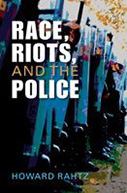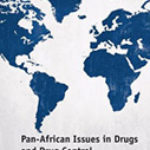Race, Riots, And The Police

Author: Howard Rahtz
Publisher: Boulder, CO: Lynne Rienner Publishers, Inc., 2016. 209p.
Reviewer: Brandon Turchan | July 2017
There has arguably been no clearer indicator, in recent years, of the racial tensions that persist in the United States than the aftermath surrounding controversial police encounters with African- Americans. These incidents are aggressively scrutinized and frequently lead to protests and, at times, rioting or civil disorder. When available, video documentation of these controversial police-citizen exchanges often goes viral via social media, and is shown repeatedly on cable news outlets for millions of people to see. In other words, this presents a scenario where video of a single incident involving questionable use of force by police is capable of influencing people’s perceptions of police across the country within hours or days of the event occurring. Potential societal consequences stemming from these incidents are substantial: damaging the perceived legitimacy of police among citizens, worsening the racial divide between police and African- American communities, and sparking violence and/or destruction of property if rioting takes place. Given the profound and far reaching impact that these incidents have in the current socio-political climate, Howard Rahtz makes a timely and valuable contribution to the conversation on police-community relations with his book Race, Riots, and Police.
Rahtz begins by placing current racial tensions into context by tracing the history of race riots in the United States dating back to the early 1900s. This historical account reveals how the dynamics of race riots have repeatedly shifted over the last 100 years, and in the process depicts some of the darkest moments in American history. The global ramifications of these events are evident by the attention that they have received from some of America’s chief enemies at the time. For example, Rahtz cites Nazi Germany’s use of the 1943 race riots in Detroit in war propaganda, and the Islamic State weighing in on the 2014 riots in Ferguson, Missouri to promote their own movement.
Rahtz describes race riots prior to 1919 as primarily involving white men responding to false rumors about a black male attacking a white female or male, by going into black neighborhoods to assault people and destroy property. He argues that this riot script changed in the Red Summer of 1919, when race riots erupted in more than 30 cities across the country. Rather than being the product of mere rumors, riots during this period were largely driven by social inequality, including structural disadvantage and economic empowerment. In the next major wave of civil disorder in 1943, Rahtz argues that structural disadvantage and inequality (exacerbated by wartime shortages) remained primary motivations for race riots; however, repressive police practices in many predominantly black communities became an increasingly influential factor. The increased focus on police was intensified in the 1960’s when hundreds of riots occurred in cities throughout the country, and police transitioned from having a somewhat peripheral role in race riots into a focal point. Specifically, during this period, Rahtz posits that routine police encounters often served as the spark for race riots, and the police themselves began to be directly targeted in the violence.
While the 1960s saw the police increasingly become the subject of race riots, Rahtz contends that the script for present day race riots was first seen in Miami, FL in 1979. The modern script for race riots, according to Rahtz, begins with an incident involving a questionable use of force by police, is followed by demands for criminal charges, and climaxes when the officer(s) in question is exonerated leading to protests that morph into rioting. One of the most notable examples offered by Rahtz of this framework in action is the 1992 riots in Los Angeles, CA that broke out following the acquittal of all officers charged in the beating of Rodney King. More recent examples of the modern race riot script include riots in Cincinnati, OH, Oakland, CA, Ferguson, MO, and Baltimore, MD.
Rahtz points to macro-level shifts in the social landscape that began in the 1960s as the reason for police, and particularly their use of force, becoming the central focus of race riots. Specifically, he argues that improvements in African- American communities due to actions taken by President Lyndon B. Johnson’s administration, including the expansion of social programs to reduce poverty and the removal of legal methods of racial discrimination (e.g., Jim Crow), left police use of force as the main source of racial tensions in the U.S. After discussing how police got into this position, Rahtz then dedicates much of the book to addressing challenges associated with mending the divide between police and African- American communities, and what lessons learned from past riots can be used by police, city administrators, and community leaders to develop riot prevention strategies and help inform response plans if a riot does occur.
When considering policies to bridge the gap between police and African- American communities, it is critical for all stakeholders to realize that the actions of a single officer in a highly publicized and intensively scrutinized use of force incident elsewhere in the country can negatively impact police-community relations in their own city. The author effectively captures the size of the task on hand when he states: “closing the gap between the black community and law enforcement will require the work of thousands of police organizations successfully reaching out and truly engaging the citizens they serve” (pp. 147). While this undertaking is clearly extraordinary, he proposes a number of areas where progress can be made towards this objective.
Rahtz highlights two primary challenges facing public officials as it pertains to preventing and responding to riots. First, police need to partner with communities in order to effectively control crime and disorder while also being compassionate and respectful. Second, if a riot does occur in their city, police and other government agencies need to be prepared to respond in a way that quickly and effectively quells the disorder. Critical to achieving this objective, Rahtz argues, is having a response plan in place that is built upon a positive relationship between political and police leaders, is flexible, and draws on lessons learned from previous riots, such as aggressively policing looting and not withdrawing from neighborhoods where disorder is occurring.
A theme repeated by the author throughout is the importance of police proactively engaging the community in a discussion of police use of force in order to enhance police legitimacy, deflate racial tensions, and develop effective force-related policies. Rahtz relies heavily on principles of legitimacy and procedural fairness when he outlines policies that could be implemented to move towards achieving these goals at the federal, state, and local levels. Throughout this discussion, he draws on existing research on police legitimacy and racial disparities in certain populations’ disproportionate representation in the criminal justice system.
At the state and federal levels, the author argues that regulation and reform are key for improving police relations with African-American communities. He details four areas where state and federal agencies may exhibit regulatory authority over local police departments in order to enhance police professionalism and effectiveness: 1) state oversight of officer misconduct and excessive force complaints where the threat of decertification could be used as a check on such behavior; 2) state investigation and potential prosecution of police deadly force incidents; 3) state regulation of data collection on lethal police use of force incidents; and, 4) state regulation of the use of police SWAT units. Other broader actions proposed by Rahtz that could be taken to improve police relations with black communities include ending the “War on Drugs,” ending policing as a source of revenue for the state, reforming civil asset forfeiture laws, and changing responses to drug crimes including decriminalizing possession, expanding the availability of drug treatment programs, and allowing police to focus their efforts on major drug traffickers rather than lower level drug crimes. On a smaller scale, he says police can engage civilians by providing opportunities to citizens to test firearms training simulators, by directly having conversations with black youth, by seeking sponsorship and support from leading groups in the black community, and by having police, political, and community leaders co-host meetings with citizens to discuss critical issues related to policing.
There are a number of aspects of police operations that Rahtz suggests could be changed to reduce racial tensions towards the police. He draws on existing research to support his call to reform three main features of police operations that negatively impact police legitimacy in predominantly African-American communities: traffic stops, “stop and frisk” practices, and the use of SWAT teams. He also offers a host of other operations-related issues that police could use to strengthen relations with the public, from police body-worn cameras to improving social conditions for African-Americans. Ultimately, he says that “the key to making the transition from fear to trust involves daily community engagement, working alongside neighborhood residents, and sharing success in resolving crime and disorder problems” (pp. 181).
This book effectively contextualizes one of the most critical issues of our time: racial tensions and police. The historical analysis of race riots is insightful and the discussion of lessons learned from past riots provides a strong foundation for developing and implementing relevant policies. That said, I found myself yearning for the author to provide more evidentiary support for his key hypothesis as to why the police became the primary focus of race riots, and how this outweighed other potentially influential movements. Policies implemented by the Johnson administration were undoubtedly influential in improving the lives of many citizens; however, readers here are left to consider for themselves how other major societal issues in the decades after the 1960s, beyond the “War on Drugs,” also may have influenced police officers’ interactions and relationships with communities. This is especially true for issues that produced disproportionately negative effects in African-American communities, such as an increasing societal preference for punitive tactics over rehabilitation (e.g., see Garland 2001), a nationwide crime wave, and the crack cocaine epidemic. While the possible explanation as to how police became the focus of racial tensions could benefit from greater exploration, nevertheless this book presents valuable knowledge for researchers and practitioners alike. I recommend the book to anyone who is interested in contemporary police-community relations and the role of police in race riots.
References
Garland, D. (2001). Culture of Control: Crime and Social Order in Contemporary Society. Chicago, IL: University of Chicago Press.
Brandon Turchan is a Research Specialist in Rutgers University’s School of Criminal Justice.


